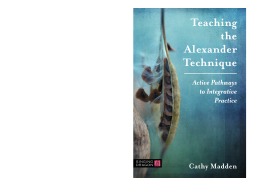
Additional Information
Book Details
Abstract
Thoughtful and accessible, this guidebook unpacks the teaching process of the Alexander Technique for new and more experienced practitioners. By demonstrating the pathway from learning the Alexander Technique for oneself to teaching it, Madden identifies the skill sets required for excellence in teaching the Alexander Technique, and shows readers how they can acquire and develop these skills themselves. Observation, communication and tactile skills are all covered, and particular attention is paid to group teaching, which is neglected in current literature. This is combined with discussion of current research on education and neuroscience, enabling the reader to build a truly informed and effective practice.
Featuring a variety of examples and stories, it will prove a valuable resource to any teacher of the Alexander Technique, both active and prospective, and to practitioners of other modalities exploring ways to deepen their practice.
Cathy Madden writes with a clarity that can only come from over 40 years of practicing and teaching the Alexander Technique. I am grateful to her for putting in to words her thinking processes that she has contemplated and refined rigorously throughout the years. A practical guide to integrating your whole self.
Ken Anno, Training Director of Alexander Technique Teacher Training, BodyChance
Cathy Madden is the principle lecturer at the University of Washington School of Drama, as well as Director of the Alexander Technique Training and Performance Studio in Seattle and Associate Director for BodyChance in Japan.
Table of Contents
| Section Title | Page | Action | Price |
|---|---|---|---|
| Teaching the Alexander Technique by Cathy Madden | 1 | ||
| Introduction | 9 | ||
| Part One: My Journey to Teaching the Alexander Technique | 11 | ||
| Ch 1. Marj’s Living Room | 13 | ||
| Ch 2. My Perspective on the Alexander Technique | 26 | ||
| Part Two: Essential Skills for Teaching the Alexander Technique | 33 | ||
| Ch 3. The Flow of Teaching | 35 | ||
| Ch 4. The Learning Playground | 42 | ||
| Ch 5. Alexander Technique Progression | 47 | ||
| Ch 6. Whole-Self Invitation | 56 | ||
| Ch 7. Having a “Yes” Plan | 64 | ||
| Ch 8. Omniservation | 67 | ||
| Ch 9. Analysis of Activity | 73 | ||
| Ch 10. Tactile Communication | 80 | ||
| Ch 11. Word Choice | 91 | ||
| Ch 12. The Art of the Question | 98 | ||
| Ch 13. Storytelling | 105 | ||
| Ch 14. Choice | 113 | ||
| Ch 15. Wholeness in the Biopsychosocial Way | 117 | ||
| Part Three: Integrative Teaching Practice | 121 | ||
| Ch 16. Deep Play Facilitation | 123 | ||
| Ch 17. The Rigor of Play and Practice | 128 | ||
| Ch 18. The Integrated Self Is Creative | 136 | ||
| Ch 19. Preparing for Teaching | 141 | ||
| Ch 20. Planning for Teaching | 148 | ||
| Ch 21. The Turn | 155 | ||
| Ch 22. Teaching Groups | 173 | ||
| Ch 23. Teaching an Introduction | 184 | ||
| Ch 24. The Drop-In Class | 195 | ||
| Ch 25. The Introductory Series | 199 | ||
| Ch 26. Short Intensives | 207 | ||
| Ch 27. Longer-Range Courses | 215 | ||
| Ch 28. The Plethora of Teaching Events | 220 | ||
| Ch 29. Games Digest | 226 | ||
| Ch 30. Tips for Turns | 263 | ||
| Ch 31. The Evolution of a Teaching Life | 276 | ||
| Alexander Technique International (ATI) | 282 | ||
| Storytellers | 283 | ||
| References | 284 | ||
| Blank Page |
